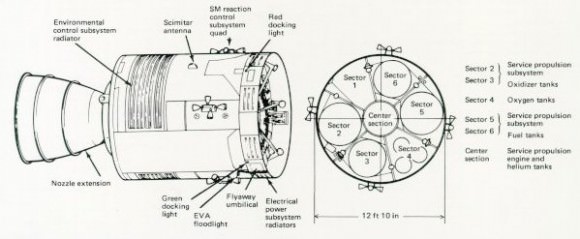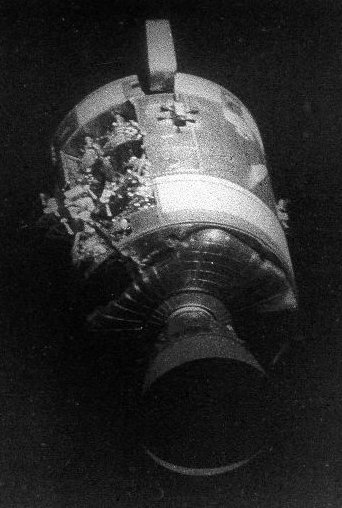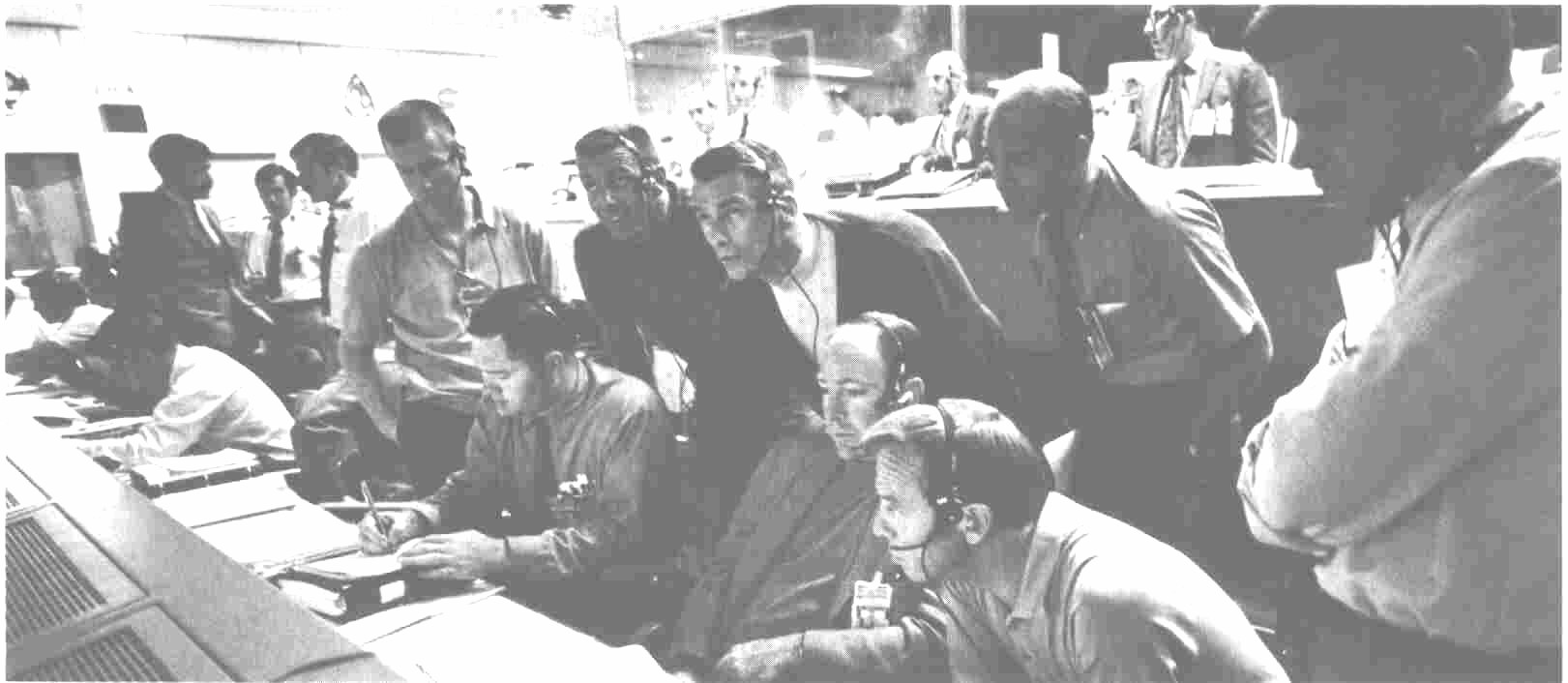Note: To celebrate the 40th anniversary of the Apollo 13 mission, for 13 days, Universe Today will feature “13 Things That Saved Apollo 13,” discussing different turning points of the mission with NASA engineer Jerry Woodfill.
After Flight Director Gene Kranz and his team in Mission Control had ascertained the true peril the Apollo 13 crew faced following the explosion of an oxygen tank in the Command and Service Module, they next faced a big decision. What was the best way to get the astronauts back to Earth? Do they get them home as fast as possible, or as safely as possible? The final decision they made likely saved Apollo 13.
“Immediately after the explosion, some recommended a faster return using the powerful service propulsion system (SPS), the engine designed for the retro burn into lunar orbit and the subsequent firing to propel the crew homeward to Earth,” said NASA Engineer Jerry Woodfill.
Using these engines to execute a direct abort burn would allow the crew to turn the spacecraft around, come around the front side of the Moon and be back to Earth within a day and a half. This was the quickest option, but it meant using the SPS, which were very near the area that had exploded on the CSM. No one knew if the engine had been damaged, too.

The risk of using using the lunar module’s descent engine was an unknown. If it failed or blew, or if the burn wasn’t executed perfectly, the crew could impact the Moon.
The other option was to go completely around the Moon on a so called free-return trajectory, which would take between four to five days to get back to Earth. But would the crew have enough consumables to survive that long?
This flight plan, too, called for an engine burn to set the spacecraft on the correct path back to Earth. But should they use the SPS engine, which was designed for this maneuver but could be damaged, or use the use the descent engine on the Lunar Module, which had never been designed for this type of use?
In his book, “Failure is Not an Option,” Kranz said it was purely a gut feeling that made him choose to take the long way – to go around the Moon and use the descent engine on the lunar lander rather than the CSM.
“Later, Gene Kranz shared he felt a foreboding about using that engine,” said Woodfill. “Nevertheless, even the use of the lander’s descent engine had some risk. The system was not expected to be fired more than once on a lunar mission. It was designed for descent from lunar orbit to landing. To use it for both Apollo 13’s mid-course correction burn (to return to the free-return trajectory) and a subsequent firing to accelerate the journey home amounted to a second firing.”
With the first burn of the LM engines working as hoped, the crew swung around the far side of the Moon (some records indicate Apollo 13 traveled the farthest distance from the far side of the Moon, making them the crew that traveled the farthest away from Earth), Mission Control considered a second burn.
Without the second burn the ship’s trajectory likely would have successfully returned the crew to Earth approximately 153 hours after launch. This provided less than an hour of consumables to spare, a margin too close for comfort.
After a much discussion and calculating, the engineers in the Mission Evaluation Room (MER) and Mission Control determined the LM’s engines could handle the required burn. So, the descent engine was fired sufficiently to boost their speed up another 860 feet per second, cutting the flight time to 143 hours – which provided a better margin for survival.

But what if the SPS engines had been fired? We will never know for sure, but Woodfill said the final photo taken of the damaged command ship after jettison from the reentry capsule appeared to show a slight deformation of the SPS engine nozzle. He believes the SPS panel adjacent to the exploding O2 tank severed the four horns from the mast of the hi-gain communication antenna system. Likely, the shrapnel from the devastating impact with those four dishes ricocheted into the SPS engine bell compromising its use. A hole in the engine’s thrust nozzle would have been catastrophic.
“The fiery bazooka-like blast of the explosion might have cracked the heat shield and damaged critical parts of that engine,” said Woodfill. “The engine’s systems were adjacent to the tunnel-like chimney located in the center of the service module. If the nozzle was deformed, surely, there would have been a potentially fatal consequence of its firing, akin to the loss of the Challenger resulting from the failed solid rocket (SRB) engine.”
Woodfill said that likely, the use of the SPS would have triggered the caution and warning combustion chamber high temperature alarm. “And its use might have made Apollo 13 a fiery meteor-like streak of light never to reach Earth,” he said. “Though a successful firing would have landed the crew days earlier in the Indian Ocean, the peril was too great.”
Tomorrow, Part 5: Unexplained Shutdown of the Saturn V engine
Other articles from the “13 Things That Saved Apollo 13” series:
Part 2: The Hatch That Wouldn’t Close
Part 3: Charlie Duke’s Measles
Part 4: Using the LM for Propulsion
Part 5: Unexplained Shutdown of the Saturn V Center Engine
Part 6: Navigating by Earth’s Terminator
Part 8: The Command Module Wasn’t Severed
Part 12: Lunar Orbit Rendezvous
Part 13: The Mission Operations Team
Also:
Your Questions about Apollo 13 Answered by Jerry Woodfill (Part 1)
More Reader Questions about Apollo 13 Answered by Jerry Woodfill (part 2)
Final Round of Apollo 13 Questions Answered by Jerry Woodfill (part 3)
Never Before Published Images of Apollo 13’s Recovery
Listen to an interview of Jerry Woodfill on the 365 Days of Astronomy podcast.


Excellent post, Nancy. One can feel the tension of all those that were involved. I look forward to the next instalment in this series.
This might have been too complex to have done, but after watching the movie Apollo 13 it struck me that lots of grief might have been avoided if the following had been done:
1 Jettison the service module right away. It was a good call that it was trashed. So why use up fuel to accelerate this dead mass around?
2 Fire the descent lunar module to reach a higher velocity after the lunar swing around. In other words with the second burn and the lower mass of the system put it on a non-Hohman trajectory with a larger Delta-vee.
3 Jettison the descent module and then upon close return to Earth fire the ascent module engine as a retro-rocket and course adjustment to place the command module on a proper re-entry course. This would have provided I think a much faster return to Earth.
This might have been too complicated to work out on the fly back then. This would have required some orbital engineering using old IBM mainframes that are clunkers compared to today’s machines.
LC
I always thought, that idea to use SPS and turn 13 around right after explosion was fiction of Apollo 13 movie. Somebody could explain to me, how could SPS be used to do that? They would need to change delta v for some 20 km/s! Doesn’t they?They used whole Saturn V to get half of that. What’s the math to make such maneuver possible?
Good chapter. You can add some sentences from the movie:
I don’t care what it was planned to do tell me what it can do Regarding the ability of the LM engine to perform the task.
Great point Lawrence! I’ve never thought of using the engine of the ascent module… So with this “ace” in the sleeve I’m wondering whether the second burn of the LM was so critical. Because if it did not fire the second time, then the ascent module engine could be used for the same purpose…
@cydonia -> even if they used the SPS engine to “turn around” the module would not turn 180 and returned to Earth. Instead it would go towards the moon, but would not reach it, returning to earth before reaching the moon. It’s like throwing a stone up in the air. If you can somehow fit a small engine to this stone to decrease its velocity in mid-flight, then the stone would return to earth quicker than without this mid-flight manouver…
Jettison the service module right away… and have no oxygen, and other supplies straight off. The capsule doesn’t hold anything outside batteries and some water. Guess you’re just trying to kill them at the start? Not to mention keep what you have, in case you have no other option.
They did fire the rockets to increase speed once on their way back to Earth. They had the fuel to do another burn if they wanted to increase speed more.
However, doing so would have required more fuel to slow down, and it would have been that much harder to get the correct trajectory to enter Earth’s atmosphere.
Retro rockets aren’t powerful enuf, coordinated for, nor in the correct spot on the spacecraft to make huge course corrections on their own.
The LM’s ascent rocket is a one fire only engine, nor did it have the control or fuel the descent engine had.
Guess if you can’t find the answers out there to cut and paste, youre physics aren’t too hot, eh?
Following from LC’s post…
I don’t know how the decision was actually taken. However, if the film was correct, the second burn was only for about 10 seconds, so it used only a fraction of the fuel for the descent stage. This firing was done without computer control. If they had jettisoned the service module, then the remaining craft would accelerate more, but would have a smaller moment of inertia, so it would be harder to control.
The descent module engine was designed to fire under zero gravity. The ascent module was designed to fire under under gravity. It also had liquid helium coolant for the several days’ stay on the moon, so it would keep. I would have used the descent engine, knowing that if it didn’t work, they could always jettison it, and use the ascent module, and if that wouldn’t work, you could always try the command module engine.
When you consider the marvelous bits of ad-hoc engineering that on Apollo XIII, it would be a brave person who chucked anything away even if it looked useless.
OT, I know. But…:
Unsubstantiated guesses. But testable; please show us your references, which I note you outright have ‘forgotten’.
Btw, have you read and understood any of LBC’s comments on physics? It sure doesn’t seem so, by the above quote.
[Also, there is a Lawrence B. Cromwell who have authored and coauthored several books, on quantum physics among them. Does that sound like the interests of anyone you know? If it does, how do you tell that it isn’t the same person?
Your presumptions are astounding.]
@ Aodhhan: The crew “got outta Dodge” (the CM) fast and hunkered down in the LM for most of the rest of the trip. The service module was complete junk after the O_2 tanks blew. There was no O_2 after the tanks blew, nor was there any power.
The Apollo craft had no retro-rockets at all. They are used to change an Earth orbit to direct the craft heat shield first into the atmosphere. The Apollo entered directly to Earth — no need for them. My point is that the fuel for the descent module could have been used for a fast return, say after the lunar swing around, and then on close encounter with the Earth the ascent engine used as a braking engine for a proper entry into the atmosphere.
This scheme was probably to complex to be worked out “on the fly,” so it was probably never even considered. Torbjorn Larsson comments might be more salient, for this would have required firing the ascent engine under conditions it might not have been designed for. Maybe the small maneuvering rockets could have been fired to generate a small acceleration (gravity) so as to make it possible to fire the ascent engines. I don’t know for sure. It is interesting in the movie, which followed the actual set of events how the second firing was done with manual control — almost a wing and a prayer sort of action.
LC
PS, something occurred to me about the iginition of the ascent engine of the LM. Most of these were sent hurling to the lunar surface after the crew was on board the CM. I presume the main engine was fired to accomplish this.
LC
You can’t jettison the descent stage of the lunar module when still days from Earth because that’s where most of the consumables (oxygen, water) are. The ascent stage only has enough for a few hours (though despite claims above, it is possible to fire the ascent stage engine more than once).
Not so sure about why they kept the service module almost the whole way back. It may have been to protect the command module heat shield.
@Quasy
Thanks. I got idea. Decrease speed and let Earth gravity do the rest. Still, no idea how much delta they would have to make to fall back to Earth at reasonable time and how precise should be maneuver to get on a tiny safe return trajectory.
LBC…not all was lost in the CM, and if all the O2 tanks were lost, there wouldn’t have been the debate on whether or not to use its engine… since without O2, they couldn’t have. ..and like I said earlier… keep what you have when keeping it doesn’t hurt you.
The Apollo craft has no retro rockets??… apparently you are talking about the capsule? Since the entire rocket…all stages and payload is considered Apollo. If you don’t get what I was saying.. then you need to do a lot of learning. Retro rockets are used throughout the flight, just like an airplane uses its alerons. No, they didn’t exist on the capsule, which is exactly why they had to be perfect entering orbit.
Coming at Earth too fast would have made this nearly impossible… if not so. Thus answering your question on why not burn more and go faster.
Nothing was worked on the fly. Each aspect of the mission was looked over by numerous individuals, discussed and tested. The reason things were done, is because they were undoubtedly the best.
You can’t just shoot as fast as you want to at a planet and enter its atmosphere… especially when you have limited resources to slow down. You cannot simply aim a trajectory down towards Earth and expect to enter it with positive consequences. If it doesn’t burn up… it will skip off the atmosphere and go back into orbit.
Usint the LM’s accent engine wasn’t much of an option for anything. It was very small by any standards, didn’t have a great deal of control, and didn’t have the flow or fuel to be used to do much. It would have been like trying to use a Prius engine on a locomotive.
You may have gotten some benefit, but not enough to control the CM and what was left of the LM.
Not to mention the fact, to use the LM’s accent engine, you would have to lose its much more powerful, manuverable and capable descent engine. You cannot use both, nor switch back and forth.
The ascent engine was big enough to get the ascent module from the lunar surface to a 100Km orbit around the moon at 5km/sec. That does not sound very small.
I suspect you are being contrary for the sake of being contrary. I will say that probably this scenario was too complex to be worked out in the time frames mission control faced.
LC
Funny how memory gives way with age but, I could have sworn that one of the feats was the transfer of power left in the CM’s batteries to the LM because they knew that the LM power alone wouldn’t be enough make it back. The reason they drug it along on the trip back.
Boy does it ever give way. In case someone sees my previous post. Got the SM (dead) mixed up with the CM. It was the other way round; LM to the CM. doh!
I won’t post again…for awhile anyway. lol